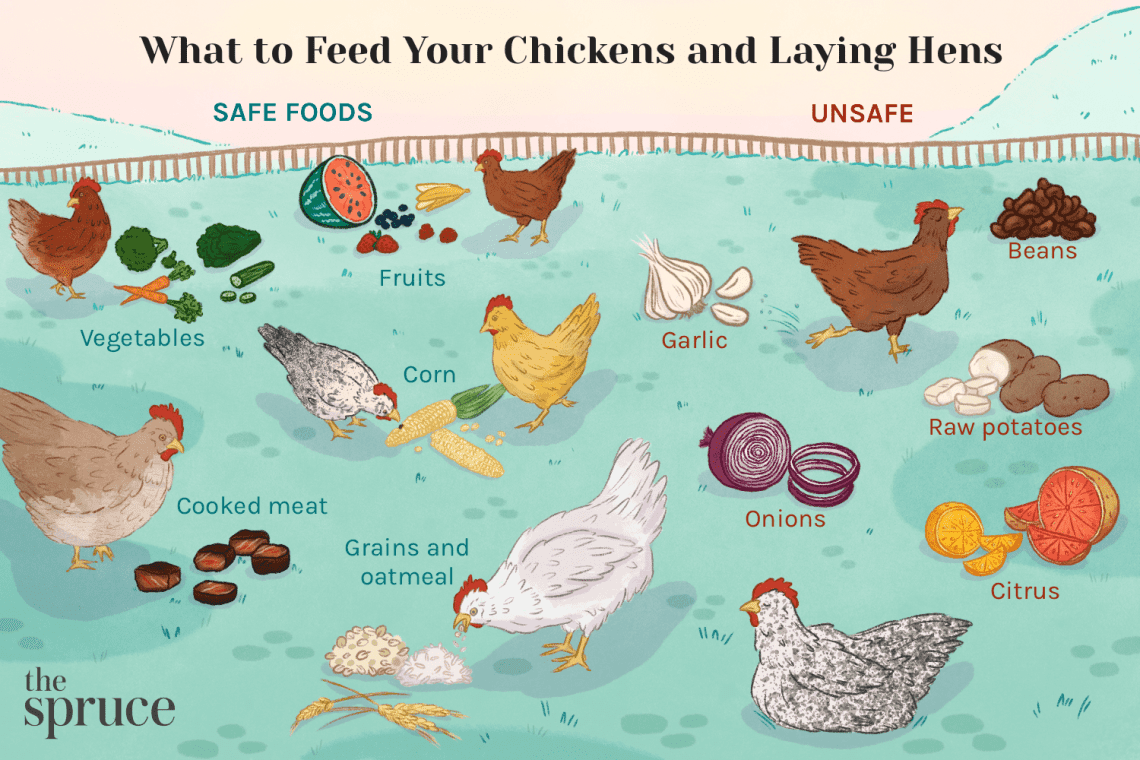
What to feed laying hens at home: tips and tricks
Many farmers make good money keeping egg hens. Peasants and summer residents breed laying hens in order to provide their families with eggs of the first freshness. Due to the fact that eggs have a high nutritional value, the demand for this product never falls.
From the conditions in which laying hens are kept, their productivity depends. The quality of feed and diet of chickens is very important. People who breed chickens of this breed are interested in what chickens should eat, how they should be fed so that they bring eggs throughout the year.
Contents
The diet of laying hens is dry
In order for chickens to have good egg production and high nutritional value of eggs in the diet of chickens must be correct and contain certain types of feed.
Feeds of mineral origin provide chickens with:
- phosphorus;
- calcium;
- sodium;
- chlorine;
- iron.
The shell is kept strong thanks to these additives. Mineral feeds include: shells, chalk, salt, feed phosphates and limestone. They need grind well before feeding and add to the grain or wet mash.
Protein-based feeds are the building blocks of laying hens. Feeds of animal and vegetable origin provide protein. Plant proteins are found in:
- yeast;
- legumes;
- flour made from nettles;
- cake and meal.
Animal proteins contained in the following products:
- cottage cheese;
- skimmed and whole milk;
- meat and bone and fish meal.
It is not recommended to feed fishmeal to laying hens as this can ruin the taste of the eggs.
Vitamin feeds are designed to replenish the vitamin supply. They increase the percentage of safety of chickens and their immunity. Recommended the following vitamin feeds:
- grated carrots;
- top;
- pine and grass flour;
- dry hay in winter and fresh herbs in summer.
Foods that are high in carbohydrates include vegetables and cereals. Grains include:
- barley;
- oats;
- wheat;
- sorghum;
- millet;
- corn.
Farmers who have a lot of experience recommend sprouting part of the grain because it increases the content of vitamin E in cereals.
Vegetable crops include:
- roots;
- potatoes.
All chickens are very fond of gourds. Bran also contains a lot of carbohydrates, it is recommended to add them to the feed dry and wet mix.
The norm for feeding laying hens in the warm season
This rule is indicative. Recommended adhere to the following rules:
- grain crops should be given in the amount of fifty grams;
- vegetables, namely carrots, turnips and beets in the amount of thirty grams;
- cereal mixtures and waste from their processing in the amount of fifty grams, these include oats, barley and bran;
- chalk and crushed shells should be given in the amount of two grams;
- fish and meat and bone meal in the amount of two grams;
- cake and waste of meat origin up to fifteen grams;
- table salt half a gram.
In a home environment, chickens eat grass and grain mixtures, kitchen waste products, and products needed specifically for laying hens: cottage cheese, vegetables, curdled milk, legumes, watermelon, melon and potato trimmings.
Meat or fish meal is partially recommended to be replaced with earthworms. The ideal option would be their special breeding on their own farm. Some give snails to laying hens because they contain a lot of protein.
How can you diversify the diet of laying hens? When it is warm outside, it is recommended to release chickens into a pen for free range. During a walk, they themselves look for worms, pinch grass, eat beetles and larvae.
Fine gravel and river sand improve chicken digestion.
The regimen that must be observed when feeding laying hens
Egg production depends on the quality of feeding and the frequency of eating. One hundred and fifty grams of feed per day for one laying hen will be enough. Birds should not be overfed. If the weight is superfluous, then the egg production will decrease.
Chickens usually eat twice a day: in the morning and in the evening. If the birds do not have the opportunity to walk and look for food on their own, then the laying hens should be fed three times a day. If there is a large paddock, it is better to feed the hens in the morning, but there must be other food in the area where the hens walk.
How and what to feed chickens in winter
How to properly feed laying hens in winter? Chickens need to eat a lot in winter. To maintain egg production in winter, it is necessary take care of the birds in the summer:
- dry hay;
- stock up on herbal and coniferous flour;
- prepare cabbage and root vegetables.
Birds need to be fed twice a day. Should be given in the morning soft warm food
- a mixture of vegetables;
- wet mixture;
- Boiled potatoes;
- food waste;
- fish broth;
- porridge;
- skimmed milk and cottage cheese.
In a wet mash, be sure to add vitamin feed, chalk, fish meal, grated shells, mixtures of herbs and table salt.
The evening diet should include: dry grain or grain dry mixes to which bran, corn waste and barley cake are added.
During the day, you need to give worms, grass and cabbage leaves. In winter, there is always a shortage of fresh herbs; pumpkin and beets can replace it.
Do not forget about vitamins. Zucchini and their seeds are very useful. Be sure to give carrots, because they contain carotene, which stimulates the readiness and activity to lay eggs. The starch found in potatoes is converted into sucrose, maintaining an energy balance.
With proper feeding, chickens always have enough calcium. However, if it is not enough, you can quickly notice: the eggshell becomes fragile, thin, and soft to the touch. Perhaps, when feeding chickens, there is not enough chalk, fish meal, meat waste.





